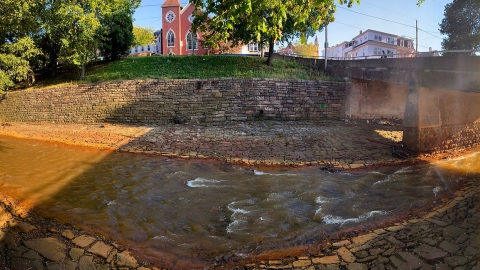
Bucknell Students Examine Environmental Impacts of Coal Mining in Shamokin, Pa.
June 23, 2022
During the coal boom of the early 20th century, Shamokin, Pa., was a thriving community. But when the mines closed and industry moved on, the town was left with only the shadows of the back-breaking work that built it.
The Shamokin Creek, orange and rusty from acid mine drainage, lies as a remnant of the progress that pulled industry and life from the valley town.
But Visiting Assistant Professor Johnathan Favini, international relations and environmental studies, sees its potential. When he was tasked with designing a project for ENST 210, Environmental Ethnography, the creek became a focal point for his students' research.
"I'm trained as an anthropologist," Favini says, "So my research is very much about getting out there and talking to people. The creek gave us a way to do that in the context of the classroom."

Students walk along the acid-stained creek in Shamokin, Pa. Photo by William Harrington ’24
For Molly O'Neil '22, an environmental studies and Italian studies double-major, the class broadened her mindset. "ENST 210 presented to me the immense value of ridding myself of biases and getting to know new places and people," she says. "As individuals, we are often engrossed in our own lives. Ethnography challenges us to abandon our instincts and, instead, deeply immerse ourselves in new environments. Only with a mix of participation, observation and research can we begin to grasp the reality of a place."
What They Learned
Working with the Shamokin Creek Restoration Alliance (SCRA) (a nonprofit that has been advocating for the stream's cleanup for over 25 years) and conducting interviews with Shamokin residents, the class developed a surprising sense of the relationship the town shares with the water. "The interviews revealed a lot about our initial research idea concerning the quality of the water in a central creek," says civil engineering major Brennan Smith '24. "But it also made us reconsider the scope of our project."
"Coal mining resulted in extreme environmental devastation," says O’Neil. "Not only is the environment still suffering, but its impacts are also causing declines in human health, high poverty levels and declining population rates."
"I heard hopelessness," Kayla McElroy '23 who is majoring in managing for sustainability and environmental studies, says of her conversations. "Despite cries for help, government organizations continue to ignore their needs. With this history of disappointment, I quickly realized how meaningful the simple care and concern of our work could be. We had the responsibility to shift this pattern of neglect."
The Impact They Made
For Steve Motyka, Vice President of the SCRA, the outcome of the research is proving valuable in his group's pursuit of environmental justice. "In the past, we've struggled to get government organizations to recognize us," he says. "This research gives a tangible, professional report that shows what we're doing. It's helped open up doors to the mayor's council and representatives on the state level. We see a real result from the research — just opening up that door."
The research, presented as a digital story map, digs into the history of the town and includes commentary from residents, examples of successful stream clean up efforts in other regions, and an overview of current revitalization plans.
For Favini's students, the outcome was unexpected and eye-opening. "It wasn’t until I interfaced with community members that I knew how big our impact could be," says O'Neil. "The people of Shamokin are passionate about their city. They hold a great sense of pride in Shamokin's history and care deeply about its current and future stages. When they talked about the creek's potential, their eyes lit up."

Garden boxes sit in the city square, nestled below the mountain of coal mine tailings. Photo by William Harrington ’24
Along with plans for green spaces and street art, the town's revitalization work places a major focus on recreational opportunities. "Shamokin is beginning to grow its reputation for outdoor and environmental recreation," Smith shares. "Hopefully they can establish a community centered around cleaning up the waterways and creating reasons for people to visit and reside there."
"The residents are devoted to transforming the town’s identity," says McElroy. "In their eyes, environmental degradation depressed the structure and vitality of their community. Through our conversations, we realized that our project had the potential to restore something greater than a creek — an entire community."

